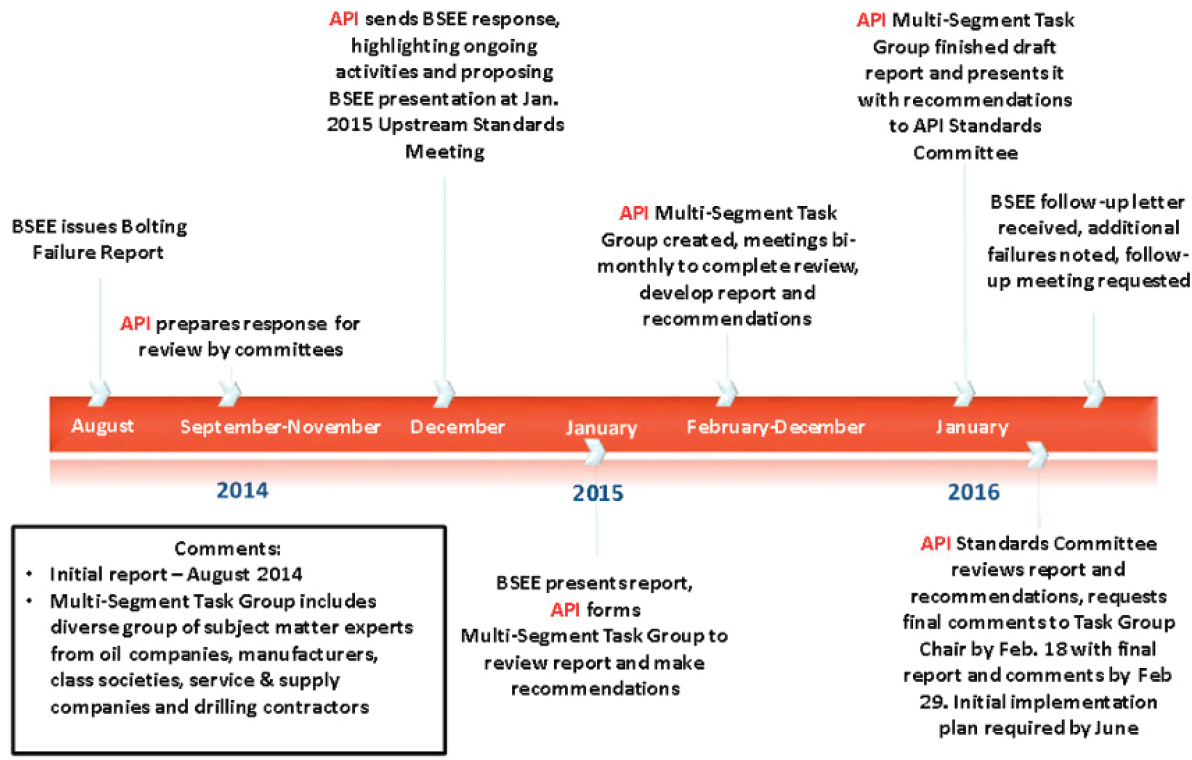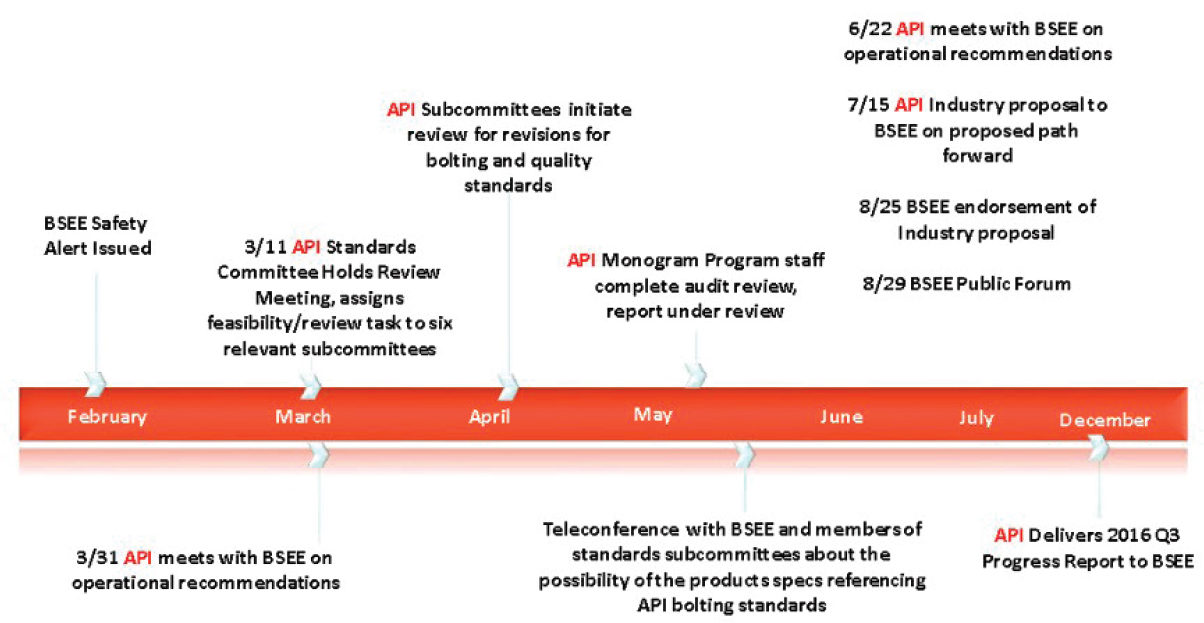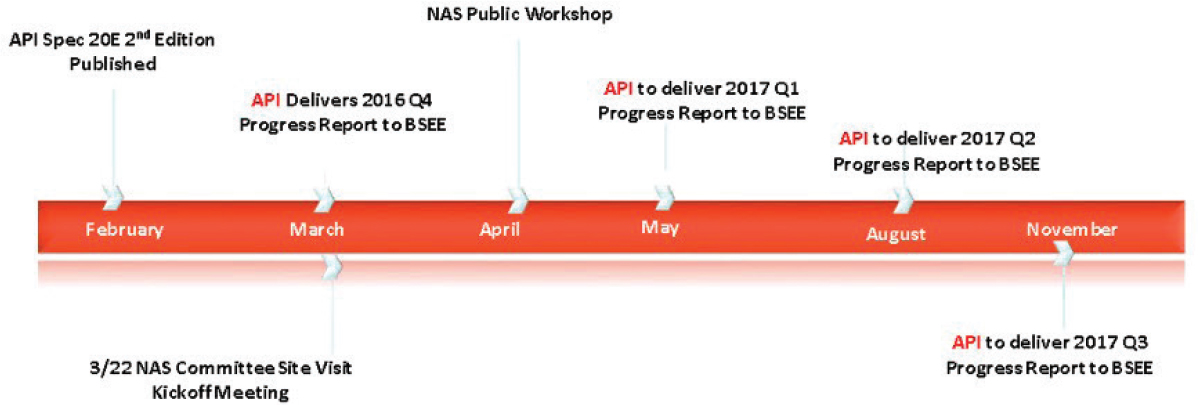F
Recent Industry and Regulator Response to Critical Subsea Bolt Failures
The purpose of this appendix is to identify gaps in industry and regulatory systems that could adversely affect the reliability of subsea bolts in critical service. This appendix highlights recent proactive actions that the oil and gas industry have already taken in response to critical bolt failures in subsea service,
These responses were in addition to the many industry and Federal Government responses that were already underway responding to the Macondo incident.
In addition to the BSEE initiatives the industrial representatives reported to the committee that the oil and gas companies, drilling contractors, and equipment manufacturers are actively working together to improve bolting reliability. They stated that the following efforts were being carried out: (1) documenting failures in an industry database, (2) developing the root cause of failures, and (3) responding to the root cause with corrective actions.
The industry representatives reported the following corrective actions to the committee: (1) through the API Multi-Segment Task Group they were developing enhanced standards; (2) Through the API Bolting Workgroup drilling contractors were executing voluntary industry actions, and tracking actions and bolting performance; (3) Manufacturers were applying updated standards to the manufacturing processes; (4) Quarterly meetings where API and industry brief BSEE on the status of industry’s bolt replacement efforts.
BOLT FAILURES
Bolts, even the large bolts used in connecting BOP components, have tended to be considered inconsequential commodities. There were several bolt failure incidents that prompted BSEE and industry to start looking in earnest at critical bolts in subsea service. These are detailed in Appendix E, “Selected Subsea Bolt Failures.”
The failure of a multitude of bolts on the Transocean Discoverer India H4 connector of a GE BOP stack on December 18, 2012, was a cluster failure of such a magnitude and critical nature that it made evident to BSEE and to industry that there was a potential systemic problem in the specification, manufacture, installation, or maintenance of bolts in operating in a subsea—many of which served a critical function.
BSEE RESPONSES
- In response to the December 18, 2012, incident on the Discoverer India, BSEE formed a Quality Control-Failure Incident Team (QC-FIT) in January 2013, within weeks of the incident. The remit of this team was to conduct technical evaluations of failed bolts, to assess “fitness for service” of the manufactured bolts, and to identify gaps in industry standards, industry practices, or regulations.1 More importantly, the team was given the task “to evaluate the possibility of additional bolt failures and make recommendations to mitigate potential risks of future failures, either domestically or internationally.”2
During its technical evaluation the team was made aware of “other offshore oil and gas failures related to bolts, studs, inserts and connectors, appearing to share similar contributing factors.”3 It was at this point that BSEE tasked the QC-FIT “to evaluate whether the causes of these other failures were related and whether evidence existed of an industry-wide issue.”4
The QC-FIT worked closely with Transocean, Chevron, and GE in evaluating the H4 failures on the Transocean Discoverer India. In order to assess the potential for an industry-wide, systemic problem, the QC-FIT team also worked with other operators, drilling contractors, equipment manufacturers, a classification society, and BSEE’s international counterparts.
___________________
1 Douglas Morris, OORP Chief; “National Academy of Sciences Workshop on Subsea Bolts Performance and Critical Drill-Through Equipment Fasteners,” presentation to the Workshop on Bolting Reliability for Offshore Oil and Natural Gas Operations on April 10, 2017.
2 Bureau of Safety and Environmental Enforcement (BSEE), Evaluation of Connector and Bolt Failures—Summary of Findings, QC-FIT Report #2014-01, Office of Offshore Regulatory Programs, August 2014, https://www.bsee.gov/sites/bsee.gov/files/bolt_report_final_8-4-14.pdf.
3 Ibid.
4 Ibid.
The QC-FIT reported its findings in August, 2014 in “QC-FIT Evaluation of Connector and Bolt Failures: Summary of Findings.” The team found that the Discoverer India H4 bolt failures were likely due primarily to hydrogen embrittlement (HE). Potential causes of the hydrogen embrittlement were identified as follows:
- Use of outdated specifications for post electroplating bake-out of hydrogen
- Failure of quality management systems to effectively cross multiple “tiers” of manufacturers and suppliers.
- Cathodic protection systems not being considered in connector and bolt design.
- Inadequate standards for connectors and bolts in subsea service.
The recommendations of the QC-FIT were the following:
- Improve various industry standards
- Initiate joint industry research initiatives to improve connector design and reliability
- Promote a comprehensive failure reporting system
- Develop regulations to ensure specific design standards are met.
This QC-FIT effort was immediate response to indications that there may be some broad, industry-wide issues affecting the reliability of critical bolting in subsea service.
- On July2, 2014, BSEE, reconvened the QC-FIT following two more subsea bolt failures:
- In February 2014, a connector leak was observed during pre-deployment testing of a LRMP.
- On June 30, 2014, 20 fasteners were found to have failed on a LMRP connector during inspection of the BOP stack on the rig between wells. Like the 2012 Discover India incident, this was a significant cluster failure.
This second QC-FIT reported its findings in February 2016 in QC-FIT Evaluation of Fastener Failures—Addendum.”5 The findings were very similar to the August 2014 report:
___________________
5 “BSEE, Evaluation of Fasteners Failures—Addendum, QC-FIT Report #2016-04, Office of Offshore Regulatory Programs, February 2016, https://www.bsee.gov/sites/bsee.gov/files/qc-fit-nov-bop-bsr-bolt-report-7282017.pdf.
- Environmentally-assisted corrosion
- Incorrect or conflicting industry standards on material hardness limits
- Need to fully implement the new API Spec 20E into the OCS regulations
- Insufficient understanding of material failure mechanisms on highly stressed materials used to construct bolts.
- In February 2016 BSEE issued Safety Alert 318 to GOM operators advising them of bolting failures.6,7
- In August 2016 BSEE sponsored a Bolt Forum with the purpose on enabling communication among the oil and gas industry, other industries, other regulators, and various standards organizations.
- BSEE initiated a project with Argonne National Laboratory to review various industry standards to identify gaps, overlaps, and conflicts.
- BSEE secured the services of NASA to be an independent third party testing laboratory.
- BSEE formed an interagency bolt action team to develop recommendations on materials for fasteners on subsea service.
- Of course, BSEE initiated this NAE study into improving subsea connector reliability.
API RESPONSE
Recognizing the potential consequences of these critical bolt failures, and especially the significance of the cluster failures, industry undertook failure analysis and root cause analysis, with participation by drilling contractors, OEMs, and operating companies.
The oil and gas industry (mostly through the API) tackled the issue—evidently cutting through a significant amount of red tape, through as hoc committees and through standards committees.
Figure F.18 shows the timeline of API activities to address the failure of critical bolts. Significant API activities are described in more detail below.
___________________
6 T. Fleece, BP, “Mitigating BOP Failures,” presentation at the Workshop on Bolting Reliability for Offshore Oil and Natural Gas Operations on April 11, 2017.
7 BSEE, “Connector and Bolt Failures,” Safety Alert 318, February 20, 2016, https://www.bsee.gov/sites/bsee.gov/files/safety-alerts/safety/safety-alert-connector-and-bolt-failures-02-02-2016a.pdf.
8 H. Hopkins, American Petroleum Institute, “Update on Industry Activities on Subsea BOP Bolting,” presentation at the Subsea Bolt Performance Houston Site Visit Kickoff Meeting, March 22, 2017.



-
In April 2016 the API held their first meeting with BSEE which resulted in the establishment of the API Multi-Segment Bolting Task Group.9 The initial driver for forming this API task group was the 2014 BSEE QC-FIT report.10 This task group was charged with the following:
- Evaluating potential types of bolting failures that might occur in the upstream oil and gas industry,
- Determine potential contributing factors to bolt failures,
- Identify current bolt failure mitigations, and
- Recommend Changes to industry standards.
This task group promulgated 20 recommendations to API to improve the effectiveness of API standards and specifications in preventing bolt failures.11
Actions taken by this task group also included the establishment of a bolt failure reporting system. This program is voluntary, and participation is growing.12
- In April 2016, BSEE undertook a review of their monogram auditing program to assess the effectiveness of their monogram auditing program.
- The API undertook a series of revisions to existing standards and development of new standards to improve their coverage of issues related to subsea bolt failures. Initially this centers on the development of two new specifications:
- API Specification 20E, Alloy and Carbon Steel Bolting for Use in Petroleum and Natural Gas Industries—the second edition was published February 2017.
- API Specification 20F, Corrosion Resistant Bolting for Use in Petroleum and Natural Gas Industries—the first edition was published in June 2015.
___________________
9 T. Fleece, BP, “Mitigating BOP Failures,” presentation at the Workshop on Bolting Reliability for Offshore Oil and Natural Gas Operations, April 11, 2017.
10 H. Hopkins, American Petroleum Institute, “Update on Industry Activities on Subsea BOP Bolting,” presentation at the Subsea Bolt Performance Houston Site Visit Kickoff Meeting, March 22, 2017.
11 Ibid.
12 T. Fleece, BP, “Mitigating BOP Failures,” presentation at the Workshop on Bolting Reliability for Offshore Oil and Natural Gas Operations, April 11, 2017.
Additionally, other API specifications are being (or already have been) revised:13
- API 6A, 21st edition, will require bolts conform to API 20E.
- API 6DSS 3rd edition, will require conformance to API 20E and API 20F for pressure boundary bolts.
- API 16A, 4th edition, will require conformance to API 20E and API 20F for pressure controlling bolting and pressure retaining bolting.
- API 16AR, 1st edition, will require conformance to API 20E and API 20F for pressure controlling bolting, closure bolting and pressure retaining bolting.
- API 16F, 2nd edition, will require conformance to API 20E and API 20F.
- API 64, 3rd edition, will require conformance to API 20E and API 20F for primary and closure bolting.
The committee recommendations for further actions by the oil and gas industry and API should not diminish the great respect the committee has for the actions they have already undertaken.
___________________
13 H. Hopkins, American Petroleum Institute, “Update on Industry Activities on Subsea BOP Bolting,” presentation at the Subsea Bolt Performance Houston Site Visit Kickoff Meeting, March 22, 2017.









